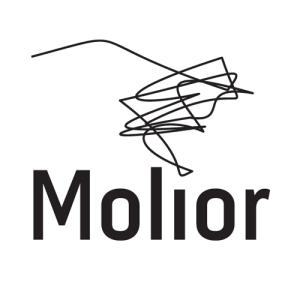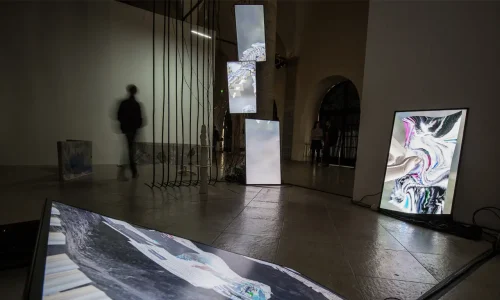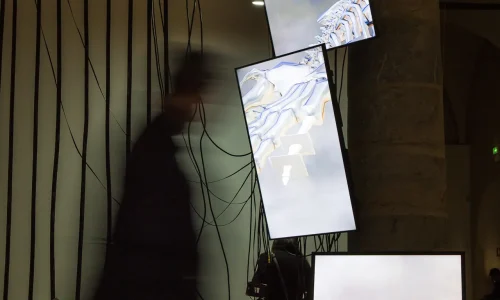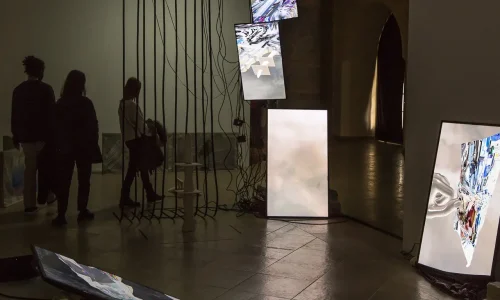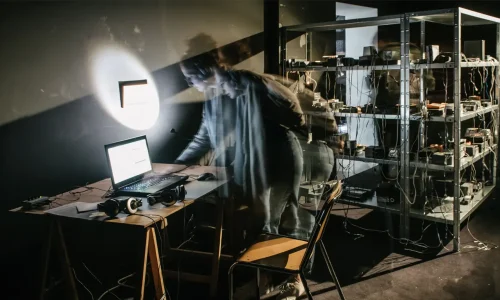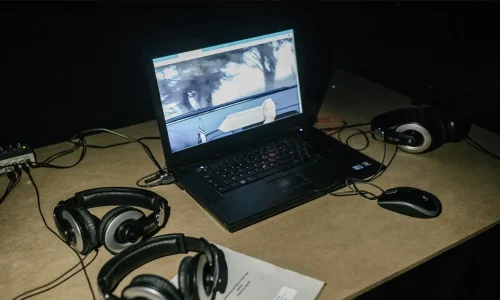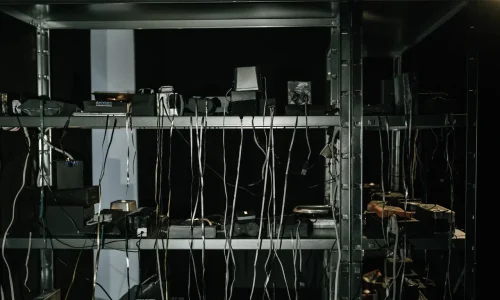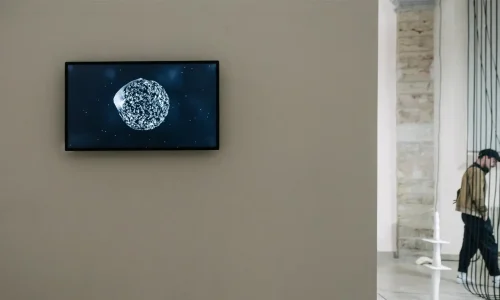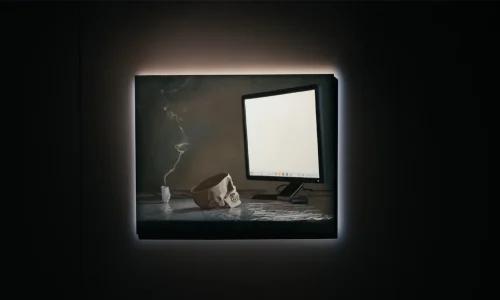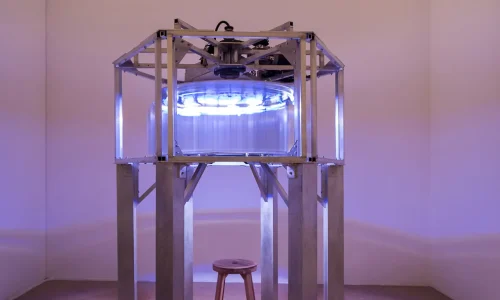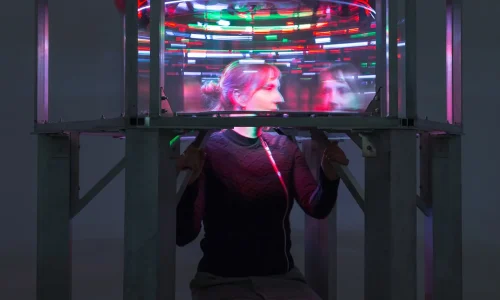"The Dead Web – La fin" at Mirage Festival
Lyon, France
From April 3rd to April 7th, 2019
Curator
“Will the Internet end soon?”
It all began in May 2015, when I read an article on lemonde.fr that spoke of the possibility of a collapse of the World Wide Web. Although this event is largely hypothetical, several articles have been written on the subject in response to a scientific symposium that the Royal Society organized around the Internet Capacity Crunch.
In a context where the network could collapse even before the end of its “adultescence” —in 2023, the Web as we know it will barely be more than 25 years old—we can try to picture the fall of the Web and the after-world that would ensue: Empty server carcasses and a sea of electronic junk? A digital oblivion on all screens? Machines imitating the Web? A handcrafted Internet?
How will the at once dematerialized and delocalized dynamics of power structures be impacted in both their evident economic and inevitably political manifestations if the network is disconnected?
But also, what can still be said or done in the meantime? How does one occupy or not– what is essentially borrowed time and space, a space-time henceforth to be shared between digital and physical realities.
In the wake of these reflections, I wanted to gather artistic proposals that echo these considerations.
[Nathalie Bachand, Curator]
The first iteration of the The Dead Web – La fin exhibition was presented in 2017 at Eastern Bloc (Montreal, Quebec, Canada).
This project has received support from the Conseil des arts et des lettres du Québec and the Canada Council for the Arts, from the ministère des Relations internationales et de la Francophonie du Québec and the ministère de l’Europe et des Affaires étrangères de la République française, as part of the Commission permanente de coopération franco-québécoise. Molior acknowledges the ongoing support of the Conseil des arts de Montréal and extends its thanks to the Québec Government Office in Paris for their precious collaboration.
Nathalie Bachand
Nathalie Bachand is an independent curator interested in digital issues and the conditions of its emergence in contemporary art.
Among her curatorial projects, her exhibition The Dead Web – The End, initially presented at Eastern Bloc (2017), has been co-produced by Molior in Europe: at the Mirage Festival in Lyon (2019), at the Mapping Festival in Geneva (2019), and at the Ludwig Museum in Budapest (2020), co-curated with Béla Tamás Kónya; she was guest curator for Art souterrain 2021 Chronométrie; her exhibition project, DataffectS, was presented at the Galerie de l’UQAM (2022); and she co-curated, with Sarah Ève Tousignant, the SIGHT+SOUND 2022 Dancing While Waiting (For the End of the World) festival, organized by Eastern Bloc (2022).
She is a member of the International Association of Art Critics (AICA), writes regularly on visual and media arts, and sits on the Board of Directors at Avatar in Quebec City. Previously in charge of development for ELEKTRA-BIAN (2006-2016), she is currently co-artistic director and project manager for Sporobole. She lives and works in Montréal.
Artists & works
Dominique Sirois & Baron Lanteigne
In Extremis
2019
Installation. Screens, ceramics (sandstone), printed polyester fabrics, cables, ducts and media players
Description
In Extremis, by Dominique Sirois and Baron Lanteigne, is the result of a very recent collaboration between the two artists. Both a sculpture and video installation—comprising passages between the two—, the work raises the question of the liminal space between the virtual and the real, the materiality of the digital and obsolescence.
Biography
Dominique Sirois’ installations take the form of sets composed of ceramics, sculptures, assemblages, drawings and prints. Her work links artisanal know-how with conceptual moorings. With her projects, she deploys mental spaces, formal and semiotic constructions linking economic, aesthetic, archaeological and digital references.
Baron Lanteigne is an artist based in Quebec City, Canada. His multidisciplinary practice depicts the overlap between the physical and the virtual through Screen-portals. His work is part of many online collections and exhibitions such as The Wrong Biennial 2018, Real-Fake, SPAMMM and Vimeo Staff Picks. This virtual presence is complemented by screenings in various international events such as SAT Fest (CA), Art Souterrain (CA), Vector Festival (CA), Dutch Design Week (NL), SONAR+D (ES), CuVo Video Art Festival (ES), Electrofringe (AU), CPH:DOX (DK) and many more. Baron Lanteigne works as an instructor and a technological consultant for artists and artist-run centres
Frédérique Laliberté
Infinitisme.com Forever A Prototype
2015-
Description
Infinitisme.com Forever A Prototype, by Frédérique Laliberté, is an eternally « progressive » web project, an autonomous collage machine that generates semi-random virtual compositions by searching in a bank of categorized and classified digital files: images, sounds, animated gifs, videos, text, etc. The result of each visit is a series of ephemeral constructions, based both on the rigidity of archival processes and on their casualness. A makeshift Internet, a sort of mimesis of itself, this website can only reuse and renew that which already exists, giving a function to hundreds of giga bytes of latent data.
More specifically, the program activates a series of commands that select random files within their respective categories. It then places these organized elements in the virtual canvas of the web page, within well-defined compartments, layers, and sequences. Taking the form of an installation, the project presents itself as a contextual environment: an simulation of a functional device. Incessantly evolving in a virtual space and time, this parallel universe is extirpated from its abstraction when visited by a web user.
The creation of Infinitisme.com Forever A Prototype was made possible thanks to the financial support of the Conseil des arts et des lettres du Québec.
Biography
On her own and with her friends, Frédérique Laliberté devotes her time to the establishment, implementation and documentation of various activities, sometimes open-ended and/or fictitious. Her practice is expressed in a variety of formats, mediums and situations, but her true love remains papermâché.
Frédérique Laliberté holds a Master of Fine Arts (MFA) from Concordia University (Montreal). A voluble artist, she has presented her projects in Canada, France, Mexico, Switzerland, China, the Sahara Desert and on the Internet. Apart from her artistic pursuits, she quenches her thirst for experimentation by making leavened bread and sailing at sea, and sometimes both at the same time, though she does not pretend to be good at either one. She lives and works in Montreal.
Julie Tremble
BPM 37093
2014
Description
BPM 37093, by Julie Tremble, is a short 3D animation that « relates » – whether fiction or reality, the uncertainty here is voluntary – the death of a star and the slow transformation of its materiality: As the artist describes, “BPM 37093 is a star, very similar to the sun, which is now dead. Scientists have discovered that by dying, the star has almost completely turned into a diamond, as the sun will do in billions of years. The video is a fantasmatic representation of this scientific phenomenon, [and the] 3D modeling, a tool favored by documentary cinema to deal with astronomical phenomena. The animation diverts this technique, perceived as realistic, to illustrate how our understanding of certain natural phenomena, whose perception is inaccessible to us, depends on fragmentary information, representations, and imagined associations.” This representation of the death of a star, symbolic of the (possible) death of the universe (and incidentally, that of the Internet) is also the birth of something else: here, a diamond. The highly accelerated temporality of this extinction of a star – 1:14 for millions of years – adds resonance to the whole exhibition project, which, putting into question the Web, also questions the notion of duration and instantaneity, as well as our representations of the world, those many synthetic images of which we are right to be wary.
Biography
Julie Tremble is a video and animation artist. Inspired among others things by cinema, literature and philosophy, she has devoted the last few years to studying the question of representation in astronomy. By way of this body of work, she is interested in the construction and diffusion of knowledge in contemporary society and in the delicate articulation of the concepts of science and truth. Julie Tremble’s work has been presented in artist centres, galleries and festivals in Canada, Europe and Indonesia.
She is the recipient of a grant from the Conseil des arts et des lettres du Québec (CALQ) and was awarded the prize for the best work of art and experimentation as part of the 31st edition of Rendez-vous du Québec.
Julien Boily
Memento Vastum
2012
Oil on board, 122 x 152 cm (48″ x 60″)
Description
The painting Memento Vastum by Julien Boily – an oil on board – tells us of a lost memory. Vastum (“waste” in Latin) refers to the notion of loss, to what is left behind in favor of a certain idea of progress. The tension between tradition and progress fuels this idea of multifaceted loss in the work of Boily.
Loss of know-how, artistic certainly, but also of traditional knowledge immediately replaced by new – often in the form of information or even data. It is a recursive dynamic that is constantly accelerating. With the arrival of novelty, what preceded tends to be evacuated. This notion of vestige crosses, in the work, those of programmed obsolescence and vanity. If in the 17th century the mirror was a recurring element in the composition of vanities – these still lifes evoking the ephemeral character of humanity – today, our electronic devices and computer tools could fulfill the same function. Among these objects that send us the reflection of our desires, our fears and our vanity, is not the Internet like a two-way mirror?
Memento Vastum is part of the Canopée Médias Collection
Biography
Inspired by the work of the old master painters of the Golden Age (17th Century), Julien Boily alters the pictorial codes of this period to represent contemporary scenes.
He abandons any quest for formal invention and uses this medium for its initial function of representing the real. The painting then participates in the work as a semantic element in its own right in addition to what is represented in his paintings.
Projet EVA (Etienne Grenier et Simon Laroche)
L’Objet de l’Internet
2017
Description
The disorganization of the world by financial capitalism, uprooted and volatile, in part fostered the emergence of the Internet. This network has gradually become the matrix through which our communities and individualities have restructured their exchanges. The promise of a greater flow of ideas, increased freedom, and even new forms of citizenship, now comes up against the power of capital and the dislocated and entropic nature of such a technological arrangement.
The Object of the Internet is an installation by Projet EVA (Etienne Grenier and Simon Laroche), evoking the idea of a mausoleum conjuring the end of the Web. Through optical and kinetic processes integrated into a device in which the visitor inserts his head, the human face is broken down into a multitude of fragments. Visitors are projected into a dystopian future where, on social media, only the traces of our selfies, which are artificially animated, remain in the form of a reflection. The latter, condemned to the status of a sterile solipsism, agitates in a sidereal void of the end of the Internet.
Biography
Projet EVA’s artworks explore relations established between humans, their environment and its mediation through technological systems.
The collective focuses mainly on the subtractive effects of technology and media on human experience, as well as on how the virtual world is increasingly woven into the urban and social landscape as it encroaches on physical reality.
Underneath the collective’s custom-made applications, robots and assorted machines an inquiry into how technology impacts the construction of our social and psychological realities as well as our living environment.
